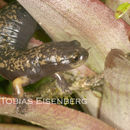Description
provided by AmphibiaWeb articles
This species is moderately sized. The total length of adults is around 111 - 156 mm (Savage 2002). Male standard length is from 54 - 72 mm whereas female standard length is from 49 - 47 mm (Savage 2002). The tail is 46 - 52% of the salamander's total length (Savage 2002). The tail is cylindrical, slender, and slightly constricted at the base (Taylor 1952). Leg length is 22 - 29% of the standard length (Savage 2002). Head width is 13 - 15% of the standard length (Savage 2002) and it is also wider than the body (Taylor 1952). The snout is short, narrow in front of the eyes, high, and truncated; viewed from above, there is also a slight convexity (Savage 2002). The canthus is rounded and the sides of the snout slope slightly to the edge of the lip (Savage 2002). There are moderate subnarial swellings and the nostrils are small (Savage 2002). The tongue is free and the salamander does not have a sublingual fold (Savage 2002). The eyes are large and protrude from the head (Savage 2002). The length of its eyelid is slightly less than the length of its snout (Savage 2002). The width of the upper eyelid is 1.8 times the interorbital distance (Savage 2002). Behind the eye, there is a depression that connects to the groove that crosses the jaw and then curves slightly forward to run across the throat (Savage 2002). Gular fold is well defined (Savage 2002). Nuchal grooves that arise from the gular fold edges are indistinct and do not reach the middorsal line (Savage 2002). Choanae are oval (Taylor 1952). Adults possess 19 - 45 maxillary teeth. and 19 - 25 vomerine teeth (Taylor 1952). In males, there are 1/2 - 1 costal folds between adpressed limbs, and in females, there are 1 - 2 costal folds (Taylor 1952). In total, the species has 13 costal grooves that are barely discernible (Taylor 1952). The cloaca has strong folds that are mostly longitudinal (Taylor 1952). A postiliac gland is also present, distinguished by a color lighter than the surrounding skin (Taylor 1952).The hands and feet have moderate digital webs but about two phalanges on the longest digit do not have webbing (Taylor 1952). The first finger is completely webbed. The inner toe is also completely webbed (Taylor 1952). On 2 - 3 of the longest digits there are subterminal pads (Savage 2002).In life, this salamander has a light brown body and limbs (Taylor 1952). The ventral side, chin, and some parts of the underside of the tail are purplish brown with many cream-colored markings (Taylor 1952). The tail is darker than the body and is almost black at the dorsal tip (Taylor 1952). Lateral and ventral yellow green marks and streaks are present, usually as irregular dorsolateral or vertical bands that lie along the costal grooves (Savage 2002). The upper eyelid is blackish (Taylor 1952).In preservative, specimens are purplish and have nonuniform cream-colored markings (Savage 2002).Bolitoglossa sooyorum appears similar to B. cerroensis, due to its lavender brown color and yellow markings, but the limbs of B. sooyorum are longer (one or no costal folds between adpressed limbs) and B. sooyorum has more maxillary teeth (43 - 79). Bolitoglossa compacta is also a similar species, but its markings are reddish, its head is broader, and its legs are shorter (Savage 2002).Originally the species was described as belonging to the genus Magnadigita, but it was found that there were no significant diagnostic characteristics distinguishing Bolitoglossa from Magnadigita (Wake et al. 1963. Thus, the older name Bolitoglossa was kept (Wake et al. 1963).A Spanish-language species account can be found at the website of Instituto Nacional de Biodiversidad (INBio) (http://darnis.inbio.ac.cr/FMPro?-DB=UBIpub.fp3&-lay=WebAll&-Format=/ubi/detail.html&-Op=bw&id=4331&-Find).
- Bolaños, F., Chaves, G., Wake, D., and Savage, J. (2009). Bolitoglossa cerroensis. In: IUCN 2010. IUCN Red List of Threatened Species. Version 2010.1. www.iucnredlist.org. Downloaded on 08 April 2010.
- Mead, L. S., and Boback, S. (2002). ''Diet and microhabitat utilization of two sympatric Neotropical salamanders: Bolitoglossa pesrubra and B. cerroensis.'' Herpetological Natural History, 9, 135-140.
- Taylor, E.H. (1952). ''Third contribution to the herpetology of the Mexican State of San Luis Potosí. Magnadigita cerroensis.'' University of Kansas Science Bulletin, 34, 724-727.
- Wake, D. B., Brame, A. H. (1963). ''The status of the plethodontid salamander genera Bolitoglossa and Magnadigita.'' Copeia, 1963(2), 382-387.
Distribution and Habitat
provided by AmphibiaWeb articles
This species can be found in humid montane rainforests in the talus on the steep slopes of the Cordillera de Talamanca in Costa Rica, from 2530 - 2990 m asl (Savage 2002). It can also be found in heavily disturbed areas (Bolaños et al. 2008).
Life History, Abundance, Activity, and Special Behaviors
provided by AmphibiaWeb articles
It breeds by direct development (Bola�os et al. 2008). Adults feed on a wide variety of prey, including coleopterans, dipterans, collembolans, and mites (acarines) (Mead and Boback 2002).
Life History, Abundance, Activity, and Special Behaviors
provided by AmphibiaWeb articles
Bolitoglossa cerroensis appears to be stable in population numbers and is relatively adaptable and common in its habitat. Local threats may include habitat loss (deforestation) due to charcoal production, but most of the range is relatively inaccessible to humans. It is found within at least one protected area, the Cerro Vueltas Biological Reserve (Bolaños et al. 2008).
Millville climbing salamander: Brief Summary
provided by wikipedia EN
The Millville climbing salamander (Bolitoglossa cerroensis) is a species of salamander in the family Plethodontidae. It is endemic to Costa Rica. Its natural habitat is subtropical or tropical moist montane forests. It is threatened by habitat loss.
- license
- cc-by-sa-3.0
- copyright
- Wikipedia authors and editors

